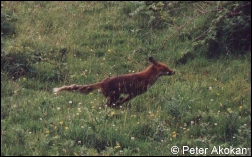
![]()
![]()

![]()
![]()
Vulpine Vicissitudes
The rise and fall of a fox population in Lough Key Country
"They're starving now, there's nothing to eat for them," said the old man I recently met walking down the lane.
"At one time they could steal a hen or pheasant or rabbit but now there are hardly any around the farms and not as many rabbits. At one time you couldn't go out without seeing a fox in a field but now it is a rare event."
While I agreed with his last statement I certainly do not believe that the remaining foxes here are all starving. If they were, they would be extinct in no time. Foxes are still very common but just not as thick on the ground as they used to be in this particular area.
It's true that at one time it was impossible to go out without seeing at least three foxes early in the morning or evening in the Lough Key Forest Park area. I have witnessed this myself when I first started foxwatching here ten years ago.

|
| Lough Key foxes are running into trouble due to man's interference with nature. |
I remember one particular June evening some years ago more than any other. I had been trying to observe some well grown fox cubs at about 8 o'clock which were lying up in very long grass in a meadow close to their woodland earth. I waited for them to become active but felt uncomfortable where I was and went to change position.
As I was moving, a huge adult fox was making its way along the field edge towards the cubs. It saw me and fled. Thinking I had ruined the evening's watch I headed home across a freshly mown field where, unexpectedly, another fox had just arrived for an evening's foraging. I was caught out in the open and could only squat down to watch with binoculars. But somehow the fox became too suspicious and fled.
At that point I stopped and looked around for any more sightings. I suddenly spotted one fox in the distance on the bank where the fields rose to a bank of jagged rocks and boulders.
I saw through my binoculars that the fox was lying down with its brush curled over the front in typical fox posture. It was looking straight in my direction and must have been watching me for some time. Then an amazing thing happened.
As I panned my binoculars along the hillside I counted twelve other foxes also watching me. Perhaps they thought that I was one of the local farmers coming to check his cattle, something they would be familiar with. The place seemed over-run with foxes, or was it?
There is nothing in this area that would especially support an unnaturally high fox population. It is a typical rural setting where foxes survive completely as woodland creatures and not urban scavengers. As far as I could see, the foxes were at a totally natural balance at a time when there was very little change or pressure on the land from modern methods of agriculture.
Although lamb/sheep carrion remains were found at one earth, many other earths in the area remained without this and it seems that foxes were very much part of the ecosystem, having enough food to find in the unspoilt countryside. This enabled them to have smaller, better patrolled territories and enough food to sustain a good population.
Can this be disrupted by intensive agriculture, the use, for example, of nitrate fertilizer to make a more productive and fertile grass yield? I believe it can. It would lead to the deaths of many worms and insects as well as small mammal and birds.
Rabbits will need to reach particularly high densities in order to be relied upon as a regular source of food when there is little else in abundance.
In Britain the field vole is said to be a very important part of fox diet but it is absent from Ireland.
Since the small mammal population is not particularly varied (although woodmice are fairly common) there is only the odd bird to catch or an opportunity to scavenge from refuse.
But since the area is predominantly rural, scavenging from human waste or other human activities plays too small a part in the local foxes' survival.
This may lead to a higher dependence on lamb and sheep carrion, especially if foxes are culled on top of everything else and new foxes move into the area.
I have also found that deer carrion, when available, plays an important part of fox diet around Lough Key Forest Park.
So from my ten year observation of local foxes I have come to the conclusion that it is likely foxes are far happier playing a real role in an ecosystem untampered with by man, surviving completely non-dependent on him.
Though the fox is a very adaptable mammal, the interference with nature by man has had a definite effect on foxes in this area.
![]()
![]()